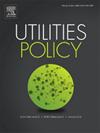Modeling determinants of the environmental performance of urban transport infrastructure in six Chinese megacities
IF 4.4
3区 经济学
Q3 ENERGY & FUELS
引用次数: 0
Abstract
Environmental performance of urban transport infrastructure (EPUTI) reflects the positive influence of urban transport infrastructure on the natural environment. It is influenced by various determinants, including the inputs of its operational facilities and numerous urban economic and social development factors. In addition, urban transport infrastructure encompasses multiple categories of transportation modes, and their environmental performances may differ; however, they are typically influenced by similar factors. Therefore, it is necessary to use a scientific method to analyze their determinants jointly. This paper examines the environmental performance of different categories of urban transport infrastructure and their determinants, taking six megacities in China as examples. Their EPUTIs are evaluated by the entropy method. The seemingly unrelated regression models are employed to analyze the determinants of the environmental performance across different categories of urban transport infrastructure. The results display that 1) the improvement of environmental performance of urban bus was not significantly relied on the increase of its operational vehicles; 2) the improvement of environmental performance of urban rail transit was mainly relied on the enlargement of scales of their operational vehicles and environmental performance of urban road was significantly negatively affected by the scale of civilian car ownership; 3) urban economic and population scales were still the important determinants of environmental performance of urban transport infrastructure; 4) the investment intensity of urban transport infrastructure and urban technological level have weaker impacts on environmental performance of urban transport infrastructure.
中国六个特大城市城市交通基础设施环境绩效的模型决定因素
城市交通基础设施环境绩效反映了城市交通基础设施对自然环境的积极影响。它受到各种决定因素的影响,包括其业务设施的投入以及许多城市经济和社会发展因素。此外,城市交通基础设施包含多种运输方式,其环境绩效可能存在差异;然而,它们通常受到类似因素的影响。因此,有必要用科学的方法对它们的决定因素进行综合分析。本文以中国6个特大城市为例,研究了不同类型城市交通基础设施的环境绩效及其影响因素。用熵值法计算了它们的等效熵值。采用看似不相关的回归模型分析了不同类别城市交通基础设施环境绩效的决定因素。结果表明:1)城市公交环境绩效的改善对运营车辆的增加依赖不显著;②城市轨道交通环境绩效的提升主要依赖于运营车辆规模的扩大,城市道路环境绩效受民用汽车保有量规模的显著负向影响;③城市经济规模和人口规模仍然是城市交通基础设施环境绩效的重要决定因素;④城市交通基础设施投资强度和城市技术水平对城市交通基础设施环境绩效的影响较弱。
本文章由计算机程序翻译,如有差异,请以英文原文为准。
求助全文
约1分钟内获得全文
求助全文
来源期刊

Utilities Policy
ENERGY & FUELS-ENVIRONMENTAL SCIENCES
CiteScore
6.80
自引率
10.00%
发文量
94
审稿时长
66 days
期刊介绍:
Utilities Policy is deliberately international, interdisciplinary, and intersectoral. Articles address utility trends and issues in both developed and developing economies. Authors and reviewers come from various disciplines, including economics, political science, sociology, law, finance, accounting, management, and engineering. Areas of focus include the utility and network industries providing essential electricity, natural gas, water and wastewater, solid waste, communications, broadband, postal, and public transportation services.
Utilities Policy invites submissions that apply various quantitative and qualitative methods. Contributions are welcome from both established and emerging scholars as well as accomplished practitioners. Interdisciplinary, comparative, and applied works are encouraged. Submissions to the journal should have a clear focus on governance, performance, and/or analysis of public utilities with an aim toward informing the policymaking process and providing recommendations as appropriate. Relevant topics and issues include but are not limited to industry structures and ownership, market design and dynamics, economic development, resource planning, system modeling, accounting and finance, infrastructure investment, supply and demand efficiency, strategic management and productivity, network operations and integration, supply chains, adaptation and flexibility, service-quality standards, benchmarking and metrics, benefit-cost analysis, behavior and incentives, pricing and demand response, economic and environmental regulation, regulatory performance and impact, restructuring and deregulation, and policy institutions.
 求助内容:
求助内容: 应助结果提醒方式:
应助结果提醒方式:


